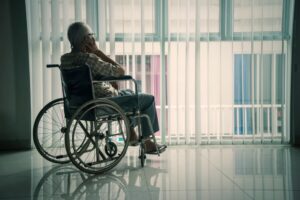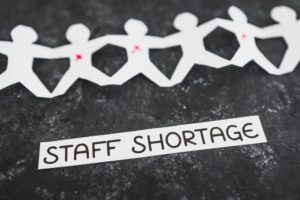How Does Understaffing Contribute to Elder Neglect?
Abuse and NeglectUnderstaffing in elder care facilities is a critical issue that directly contributes to elder neglect and even abuse. When there are not enough staff members to provide adequate care and attention to the elderly residents, their basic needs can often go unmet. This can include things like regular personal hygiene, proper nutrition, and supervision to prevent accidents or falls.
The consequences of understaffing can be devastating, leading to physical and emotional neglect, abuse, and even life-threatening situations. It is important that we recognize the significant impact of understaffing on the well-being of our elderly loved ones. If you suspect that your elderly family member or loved one is being neglected due to understaffing at their care facility, seek legal advice and protection. Contact an elder neglect attorney near you to ensure the rights and safety of your elderly loved one are protected.
What Is Elder Neglect?
 Elder neglect is a form of mistreatment that involves the failure to meet the basic needs and care requirements of older adults. It occurs in various settings, such as nursing homes, assisted living facilities, and even within the individual’s own home.
Elder neglect is a form of mistreatment that involves the failure to meet the basic needs and care requirements of older adults. It occurs in various settings, such as nursing homes, assisted living facilities, and even within the individual’s own home.
Elder neglect includes a range of behaviors that result in harm or distress to elderly individuals. It involves the failure to provide essential care, support, and supervision. Some examples of elder neglect include:
- Failing to meet basic needs such as food, hygiene, and medical care.
- Emotional neglect, such as ignoring residents or isolating them from social interaction.
What is the Difference Between Abuse and Neglect?
While elder abuse is typically intentional, neglect is often unintentional. Neglect occurs when caregivers fail to provide the necessary care and attention due to factors such as understaffing, lack of training, or burnout. It is important to note that both abuse and neglect can have severe consequences for the well-being of elderly individuals.
Signs and Symptoms of Elder Neglect
Recognizing the signs and symptoms of elder neglect is necessary to protect your loved ones and ensure they receive the care they deserve. These signs can manifest in multiple ways, including physically, emotionally, behaviorally, and environmentally.
Physical Signs
Physical signs of elder neglect are often the most apparent, as they directly impact an individual’s health and well-being. Watch for the following:
- Bedsores (Pressure Ulcers): These are painful sores caused by prolonged pressure on the skin, often resulting from immobility and caregivers’ lack of proper repositioning. Untreated bedsores can lead to serious infections.
- Malnutrition: Significant weight loss, muscle wasting, or visible frailty may indicate the individual is not receiving proper nutrition.
- Dehydration: Dry mouth, cracked lips, sunken eyes, and dark urine are signs of dehydration, which can be life-threatening if not addressed promptly.
- Poor Hygiene: Dirty clothing, unwashed hair, untrimmed nails, and body odor are clear indicators that basic grooming needs are being neglected.
- Untreated Medical Issues: Worsening chronic conditions, unaddressed pain, or signs of untreated injuries, such as cuts or bruises, may indicate neglect.
- Frequent Infections: Recurring urinary tract infections, respiratory infections, or skin infections may result from unsanitary living conditions or lack of proper care.
Emotional Signs
Emotional neglect can be just as harmful as physical neglect, leading to psychological distress and a diminished quality of life. Be on the lookout for these emotional symptoms:
- Withdrawal and Isolation: A sudden lack of interest in social activities or communication with loved ones can be a sign of emotional neglect.
- Depression: Persistent sadness, hopelessness, or apathy may develop when an elderly individual feels ignored or undervalued.
- Fearfulness or Anxiety: Neglected elders may appear fearful, particularly around caregivers, as a result of mistreatment or neglect.
Behavioral Signs
Neglect can also lead to behavioral changes, which may provide additional clues about the quality of care an elderly individual is receiving:
- Frequent Complaints: Repeated expressions of discomfort, hunger, thirst, or dissatisfaction with care should not be ignored.
- Refusal to Speak About Care: A reluctance to discuss their treatment may indicate fear or discomfort caused by neglect.
- Unexplained Agitation: Restlessness or repetitive behaviors, such as rocking or pacing, can signal distress.
Environmental Signs
In addition to changes in the elderly’s condition, the environment in which they live can also reveal signs of neglect. Keep an eye out for the following:
- Unsanitary Living Conditions: Dirty rooms, foul odors, soiled bedding, and unclean bathrooms indicate neglect of the resident’s environment.
- Clutter and Hazards: Excessive clutter, spills, or unsafe conditions, such as loose rugs or broken furniture, can create a dangerous living space.
- Inadequate Supplies: A lack of essential items like clean clothing, hygiene products, or medical supplies suggests neglect.
- Limited Staff Presence: Overwhelmed or visibly stressed staff, long delays in responding to calls, or insufficient caregivers can signal systemic neglect in the facility.
Cognitive and Social Signs
Elder neglect can also affect cognitive function and social engagement. Some signs to monitor include:
- Cognitive Decline: Increased confusion, memory loss, or disorientation can result from malnutrition, dehydration, or lack of proper medical care.
- Loss of Social Interaction: If your loved one becomes increasingly isolated, it may be because the staff has not made an effort to involve them in group activities or outings.
- Disinterest in Hobbies: A sudden loss of interest in previously enjoyed activities can point to neglect in providing stimulating or meaningful experiences.
Trust Your Instincts
Caregivers and loved ones often notice subtle changes in an elder’s condition or demeanor before more obvious signs emerge. Trust your instincts—if something feels off, investigate further. Neglect can take many forms, and early intervention can make all the difference in protecting your loved one’s health, safety, and dignity. If you suspect neglect, now is the time to act. An elder abuse attorney can help with the next steps.
Understanding Understaffing in Care Facilities
What Does Understaffing Mean?
Understaffing occurs when not enough staff members are available to adequately care for the residents of an elder care facility. It often results in a staff-to-patient ratio below industry benchmarks and standards. Adequate staffing is critical to ensuring the well-being and safety of elderly residents.
Reasons for Understaffing
There are several reasons why elder care facilities may be understaffed:
- Cost-cutting measures by for-profit care facilities: Some facilities prioritize their profits over the quality of care, leading to insufficient staffing levels.
- Challenges in retaining staff: Low earnings, high levels of burnout, and lack of training can result in high turnover rates, making it difficult to maintain adequate staffing levels.
How Understaffing Impacts Day-to-Day Operations
Understaffing has significant impacts on the day-to-day operations of care facilities:
- Overburdened staff: When there are not enough staff members to handle the needs of all residents, the existing staff becomes overworked and overwhelmed, resulting in a decreased ability to meet residents’ needs effectively.
- Reduced quality of care: Limited time and resources due to understaffing can lead to substandard care, neglecting important aspects of residents’ well-being.
How Understaffing Leads to Elder Neglect
Missed Basic Care Needs
Understaffing contributes to the neglect of basic care needs, such as personal hygiene, meal assistance, and medication management. When there is a shortage of staff, it becomes challenging to provide individualized attention to each resident, leading to unmet needs.
Delayed Medical Attention
Insufficient staffing can result in delayed medical attention for elderly residents. Staff members may not promptly respond to injuries, illnesses, or emergencies, exacerbating their conditions and risking their lives.
Increased Risk of Falls and Injuries
Falls are a significant concern among the elderly, and understaffing can increase the risk of these accidents. When fewer staff members are available to provide supervision and assist with mobility, elderly residents may experience more falls, leading to injuries and other related complications.
Emotional Neglect
Minimal interaction with residents due to understaffing can result in emotional neglect. Elderly individuals require companionship and social interaction to maintain their mental well-being. When these needs are not fulfilled, they may feel isolated, lonely, and depressed.
Staff Burnout and Mistakes
Understaffing puts a tremendous burden on the existing staff in care facilities, leading to burnout. Overworked employees are more likely to make errors or overlook critical needs, contributing to elder neglect.
The Broader Consequences of Understaffing
 The consequences of understaffing extend beyond immediate neglect. Elderly residents may experience physical and emotional deterioration due to the lack of proper care. It can lead to a reduced quality of life and increased mortality rates.
The consequences of understaffing extend beyond immediate neglect. Elderly residents may experience physical and emotional deterioration due to the lack of proper care. It can lead to a reduced quality of life and increased mortality rates.
Families who entrust the care of their elderly loved ones to these facilities may experience emotional distress and a loss of trust. Discovering neglect can be devastating, and families may face financial strain from seeking alternative care or handling medical expenses.
Understaffing also affects staff members themselves. High turnover rates due to burnout create a vicious cycle of understaffing, further compounding the issue and making it even more challenging to address the problem effectively.
Legal Rights and Protections for Elderly Residents
Federal and State Regulations
Both federal and state laws outline regulations and guidelines for elder care facilities. The Nursing Home Reform Act is one such law that requires facilities to maintain adequate staffing levels and provide a certain standard of care. These regulations are in place to protect the rights and well-being of elderly residents.
Residents’ Rights
Elderly residents have the right to dignity, safety, and proper medical attention. Families and loved ones should be aware of these rights and advocate for their proper enforcement.
Facility Accountability
Under the law, facilities can be held legally responsible for neglect caused by understaffing. Families can take legal action to hold these facilities accountable and seek justice for their elderly loved ones.
What to Do If You Suspect Elder Neglect Due to Understaffing
If you suspect your loved one is experiencing neglect due to understaffing, acting promptly and decisively to protect their well-being and seek justice is essential.
Document Evidence
Gathering evidence is a critical step in addressing elder neglect. This documentation can help substantiate your claims and protect your loved one. Consider the following actions:
- Photographic Evidence: Take clear, timestamped photos of physical injuries, unsafe living conditions, or other concerning signs.
- Medical Records: Obtain copies of your loved one’s medical records to track signs of neglect or patterns of inadequate care.
- Written Notes: Maintain a detailed journal of incidents, dates, and times when neglect occurred, along with any related conversations with staff.
- Witness Testimonies: Speak with other residents or family members who may have observed similar neglect and ask if they are willing to provide statements.
Address Concerns with Facility Management
Before escalating the situation legally, you should attempt to resolve the issue internally by addressing your concerns with the facility management. Here’s how:
- Request a Meeting: Arrange a formal meeting with the facility’s administrator or manager to discuss your concerns.
- Present Evidence: Share your gathered evidence and clearly outline your observations and concerns.
- Request an Action Plan: Ask for specific steps the facility will take to address the understaffing and improve your loved one’s care.
- Follow-Up in Writing: Document your complaints and the facility’s response in writing, including emails or letters, to create a record of the interaction.
If the facility is unwilling or unable to make meaningful improvements, further action may be necessary.
Contact an Elder Neglect Lawyer
 When the facility fails to address the neglect or if the situation worsens (including if your loved one is in danger or has been harmed), seek legal help. Experienced elder neglect lawyers are well-versed in holding negligent facilities accountable and can guide you through the legal process. Here’s how they can help:
When the facility fails to address the neglect or if the situation worsens (including if your loved one is in danger or has been harmed), seek legal help. Experienced elder neglect lawyers are well-versed in holding negligent facilities accountable and can guide you through the legal process. Here’s how they can help:
- Investigating Neglect: A lawyer can conduct a thorough investigation into the facility’s staffing practices, training procedures, and compliance with state and federal regulations. They will examine staffing records, employee training logs, and prior complaints to build a case against the negligent parties.
- Gathering Evidence: Using medical records, inspection reports, expert testimony, and resident accounts, an elder neglect lawyer can build a strong case to demonstrate neglect. The goal is to prove that the facility failed to meet its duty of care to the elderly resident.
- Filing Complaints: Your lawyer can file formal complaints with regulatory agencies like the state’s Department of Health or Adult Protective Services.
- Pursuing Compensation: If neglect due to understaffing is proven, an elder neglect lawyer can help secure compensation for medical costs, pain and suffering, and emotional distress. They will negotiate on behalf of the injured party to ensure they receive fair and just compensation.
Report Neglect to Authorities
In addition to seeking legal counsel, you should report any suspected neglect to the appropriate authorities. Most states have agencies dedicated to protecting vulnerable adults, such as Adult Protective Services (APS). Filing a report can trigger an investigation and prompt immediate intervention if necessary.
Take Action Today
Understaffing in elder care facilities is a serious issue that significantly contributes to elder neglect. It is essential to understand the impact of understaffing on the well-being of our elderly loved ones and take action to address this problem.
If you suspect your loved one is being neglected due to understaffing, it is important to seek legal advice and protection. Contact an elder neglect attorney near you to ensure the rights and safety of your loved one are protected. Together, we can hold negligent facilities accountable and seek justice for those affected by elder neglect.
Nathan Hughey, an attorney and fourth-generation South Carolinian, founded Hughey Law Firm in 2007. Before that, he spent five years defending nursing homes and insurance companies. Leveraging his experience, he now advocates for those injured or wronged by such entities, securing over $290 million in verdicts and settlements.
